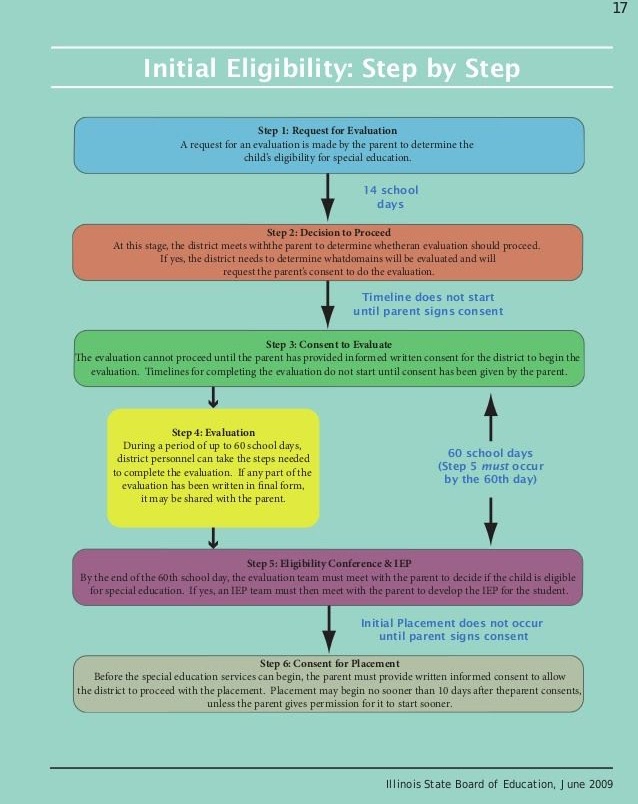Special Education Procedures

Special Education Process
Parents, school personnel, students, or others may make a request for evaluation. If the parent(s) request an evaluation to determine whether their child has a disability and needs special education, the school district must complete a full and individual evaluation. If it refuses to conduct the evaluation, it must give the parent(s) appropriate notice and let the parent(s) know their rights. Parents must give permission in writing for an initial (first time) evaluation and for any tests that are completed as part of a reevaluation.
A team of qualified professionals and the parents(s) will review the results of the evaluation, and determine if their child is eligible for special education services.
If their child is not eligible, the parent(s) will be appropriately notified and the process stops. However, the parent(s) have a right to disagree with the results of the evaluation or the eligibility decision.
If the parent(s) and the school district agree that the child is eligible for services, the parent(s) and the school staff will plan the child’s Individualized Education Program (IEP), at an IEP team meeting. The parent(s) are an equal member of this team.
The IEP lists any special services the child needs, including goals the child is expected to achieve in one year, and objectives or benchmarks to note progress. The team determines what services are in the IEP, as well as the location of those services and modifications. At times, the IEP and placement decisions will take place at one meeting. At other times, placement may be made at a separate meeting (usually called a placement meeting.) Placement for the child must be in the Least Restrictive Environment (LRE) appropriate to the child’s needs. He or she will be placed in the regular classroom to receive services unless the IEP team determines that, even with special additional aids and services, the child cannot be successful there. The parent(s) are part of any group that decides what services the child will receive and where they will be provided.
If the parent(s) disagree with the IEP and/or the proposed placement, the parent(s) should first try to work out an agreement with the child’s IEP team. If the parent(s) still disagree, the parent(s) can use the due process rights.
If the parent(s) agree with the IEP and placement, the child will receive the services that are written into the IEP. The parent(s) will receive reports on the child’s progress at least as often as parents are given reports on their children who do not have disabilities. The parent(s) can request that the IEP team meet if reports show that changes need to be made in the IEP.
The IEP team meets at least once per year to discuss progress and write any new goals or services into the IEP. A parent can agree or disagree with the proposed changes. If the parent(s) disagree, the parent(s) should do so in writing.
If the parent(s) disagree with any changes in the IEP, the child will continue to receive the services listed in the previous IEP until the parent(s) and school staff reach agreement. the parent(s) should discuss the concerns with the other members of the IEP team. If the parent(s) continue to disagree with the IEP, the parent(s) have several options, including asking for additional testing or an Independent Educational Evaluation (IEE), or resolving the disagreement using due process.
The child will continue to receive special education services if the team agrees that the services are needed. A reevaluation is completed at least once every three years, unless the parent(s) and the school district agree that reevaluation is not needed, to see if the child continues to be eligible for special education services and to decide what services he or she needs.
